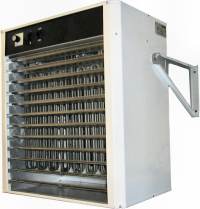
| ||||
W. Tombling Ltd.
Wembley House
Dozens Bank
West Pinchbeck
Spalding
Lincolnshire
PE11 3ND
U.K.


What size heater do I need?
Every day we are asked ‘what size heater do I need’ or ‘what size heater do I need for a building of x square feet or meters’ no matter how the question is worded the answer is the same – you need to do a heatloss calculation!
What is heatloss?
All buildings loose heat through their walls, roof, floor, doors and windows, and through ventilation and air leaks in the skin of the building, the total of all these losses is called the heatloss.
Why is heatloss so important?
To raise the temperature of a building you must replace
heat quicker than it is being lost.
Put anther way, to raise the temperature of a building the output of the heaters installed must exceed it's heatloss.
This is a very important concept:-
If the output of the heaters is less than the heatloss of the building, the indoor temperature will fall. Symptoms of this are heaters which run continuously, and cold air coming from the heater outlets.
If the output of the heaters is equal to the heatloss of the building the temperature will be stable but will not rise. The heaters will run continuously, if the surrounding air is cold, the outlet air will be cold.
Only when the output of the heaters is greater than the heat loss of the building will the temperature rise. The heaters will run continuously until the building reaches the required temperature, and will then cut in and out as required.
This disproves a very common misconception; ‘a small heater is better than none’. The only way to effectively heat a building is to install heater(s) with a total output greater than the heatloss.
But I’m not a heating engineer how do I work out the heatloss?
We have produced a step by step guide how to perform a manual calculation. This is the most accurate method, but it does take some time. Understandably most people prefer to use our on-line heatloss calculator, which performs a simplified heatloss calculation in a few minutes.
Using our on-line heatloss calculator
Our on-line calculator is available wherever you see the ‘on-line calculator’ symbol. To use it you need to know the length, width, height, type of insulation of your building and temperature you want to maintain.
Length, width and height – These are the maximum dimensions of the space you want to heat. For example if you want to heat a small area inside a much larger space, you must use the dimensions of the larger space because fan heaters will circulate heat throughout the whole area. If you want to heat specific areas consider radiant heaters instead.
For pitched roofs use the average height. For odd shaped spaces use the maximum length and width.
Temperature – This is indoor temperature you want to maintain.
The Health & safety executive - HSE stipulates the minimum indoor temperature as 16C (or 13C for strenuous activities) within 1 hour of starting work. Obviously this is the minimum; the actual temperature for comfort could in fact be as high as 28C.
Type of insulation – We have divided insulation into 4 broad bands:
Hardly any - Structure clad in corrugated iron or asbestos sheet.
Poor / high leakage - Little insulation, single brick walls, single glazed windows, no roof insulation.
Average - Cavity or insulated walls, insulated roof, single glazed windows.
Good / low leakage - Well insulated walls, roof and floor, double glazing etc.
If you are not sure which level of insulation best matches your building use the lowest. For instance if you cannot decide between ‘average’ or ‘poor/high leakage’ use ‘poor/high leakage’
Once you know how many kilowatts of heat you require divide this by the size of heater you have chosen to find the minimum number of heaters needed.
For instance if the calculator says you need 100kw, you would need 100/21 = 5 EA21 21kw heaters.
Example: A small industrial unit in the south of England measuring 8m by 15m and 3.5m high needs to be
maintained at 16C. The unit has cavity walls and a corrugated asbestos roof.

The roof has no insulation, but the walls have a cavity. Therefore heatloss calculation should be carried out for both types of
insulation; ‘poor/high leakage’ and ‘average’. Using our on-line heatloss calculator the
recommended heater size is 29kw
for average and 39kw for ‘poor/high leakage’ insulation.
To provide a safety margin 2-VEA21
wall mounted space heaters with a total output of
42kw
would be needed.
What if I don’t do a heatloss calculation?
It is impossible to choose a heater until you have done a heatloss calculation. To aid you we have provided a free on-line heatloss calculator and step by step guide to manually performing heatloss calculations.
It’s your responsibility to ensure the heater(s) you order are big enough to heat your building. You cannot return a heater because it is too small for your application. If you have any doubts about the size of heater you need, contact a local heating engineer for advice before you order.
Further reading
Are space heaters suitable for my building?
Is my electricity supply suitable?
How much do electric space heaters cost to run?
How warm do electric fan heaters get?
Disclaimer: Our heat-loss calculator is a simplified tool designed to provide a quick calculation of
heatloss for typical buildings. It is not intended to be used for ‘special cases’ i.e.
buildings of unusual construction, where doors or windows are permanently open, or where there are large heat sources such as
furnaces.
The figures produced rely on the information provided by users, and should be used as a guide; it is not a replacement for a
detailed heatloss calculation carried out by a suitably trained and qualified person. W. Tombling Ltd accepts no responsibility
for losses or liability resulting from its use.
If you found this page useful, please take a moment
to tell a friend or colleague about it.
Copyright � 2003/6, W. Tombling Ltd.